Effective Strategies for Outdoor Fly Control


Intro
Swarming flies are not only a nuisance, but they also pose risks to outdoor activities and can affect the quality of our environments. The presence of these pests is often a sign of underlying issues in gardens and yards, which can be resolved with appropriate strategies. Understanding the behaviors and habits of swarming flies is crucial to implement effective control and prevention measures. This guide explores various methods aimed at managing these pests, from environmental modifications to various control techniques.
Understanding the Pest
When dealing with swarming flies, it is essential to first understand the creature itself. Not all flies behave the same way, and different species may require unique strategies for management.
Identification
Swarming flies are typically identified by their rapid movements and large formations in the air. Common species that exhibit swarming behaviors include house flies and fruit flies. Noting their physical characteristics can aid in identifying the type of fly present. For example, house flies are often gray and have four dark stripes on their thorax, while fruit flies are smaller with a tan body and red eyes. Proper identification can direct specific control approaches more effectively.
Life Cycle
Flies undergo complete metamorphosis, including the egg, larva, pupa, and adult stages. The life span of a fly depends on various factors such as species and environmental conditions. For most common species, adults can live for a few weeks to several months. Understanding their life cycle is vital, as targeting a specific stage can be more efficient. For instance, destroying their breeding sites can effectively decrease their population in outdoor areas.
Pest Prevention Strategies
Preventing swarming flies from becoming a nuisance starts with making small changes to the outdoor environment. By addressing factors that attract them, homeowners can reduce their chances of infestation.
Environment Modification
Environmental modifications can significantly impact fly populations. Flies tend to thrive where food sources are abundant, including trash, compost piles, and overripe fruit in gardens. Keeping these areas clean is crucial. Here are some strategies:
- Seal garbage bins tightly. This prevents flies from accessing food waste.
- Regularly clean outdoor areas. Remove food remnants and spills that could attract flies.
- Manage compost piles. Keep them covered and turned frequently to control odors that may attract flies.
Physical Barriers
Creating physical barriers is another effective strategy. These can prevent flies from entering living spaces or breeding in gardens. Consider the following:
- Install screens on windows and doors. This can help keep flies out of homes.
- Use nets for outdoor dining areas. They can form a barrier against flies during meals.
- Create a raised garden bed. It may help some gardeners experience fewer fly problems.
Control Methods
When prevention strategies are not sufficient, control methods may be necessary. Both chemical and biological approaches can help manage swarming flies effectively.
Chemical Control
Chemical control methods involve the use of insecticides. While these can be effective, it is important to use them judiciously. Some households prefer products like Pyrethrin and Permethrin, which are derived from natural sources yet can be very effective against swarming flies.
- Always follow the manufacturer’s instructions for application and safety.
- Consider the potential impacts on beneficial insects and the surrounding environment when applying chemicals.
Biological Control
Biological control methods leverage natural predators or parasites to control fly populations. For example, certain nematodes can effectively target and kill fly larvae in the soil. Another option is introducing decoys or bait traps that attract flies away from areas of concern.
Effective pest management requires a comprehensive understanding of the pest and its environment, combined with skilled implementation of control measures.
Understanding Fly Behavior
Understanding fly behavior is a fundamental aspect of managing their populations effectively. Knowledge of how flies behave helps in designing strategies that can reduce their chances of multiplying and gathering in swarms. Flies often thrive in specific environments, and comprehending their patterns is key to prevention. This section will explore the life cycle of flies and the conditions that favor their swarming, which forms the basis for effective management tactics.
Life Cycle of Flies
The life cycle of flies consists of four distinct stages. Knowing these stages provides insight into their development and can inform control strategies.
Egg stage
The egg stage is the first phase of a fly’s life cycle. Female flies typically lay eggs in warm and moist environments. These eggs are very small and often nearly invisible to the naked eye. Their early development begins in ideal conditions, such as those found in decaying matter. Understanding this stage is important because the quicker these eggs are removed or the conditions altered, the less chance they have to develop further.
Larval stage
Once the eggs hatch, they enter the larval stage, commonly known as maggots. At this point, they are primarily focused on feeding. This stage is essential for their growth, as the larvae consume organic material to gain energy. Their ability to thrive in rotten food makes them a nuisance in gardens as they multiply quickly. This is a crucial time to implement control measures since disrupting this phase can significantly reduce their numbers.
Pupal stage
The pupal stage follows the larval stage, marking a transformative phase where the larva develops into an adult fly. This stage is often spent in a protective casing, either in the soil or surrounding environment. While the pupae are less active, they are not immune to control strategies. Monitoring this stage can alert homeowners about potential outbreaks of adult flies in the near future.
Adult stage
Finally, the adult stage is when flies are most visible and problematic. Adult flies are able to reproduce quickly, resulting in exponential increases in their populations. They are drawn to food sources and breeding sites, making their presence especially bothersome during warm months. Recognizing their behaviors during this stage can help to devise effective traps or other control techniques.
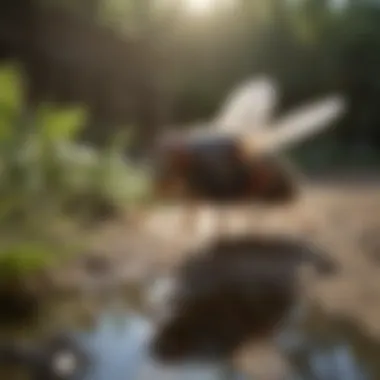
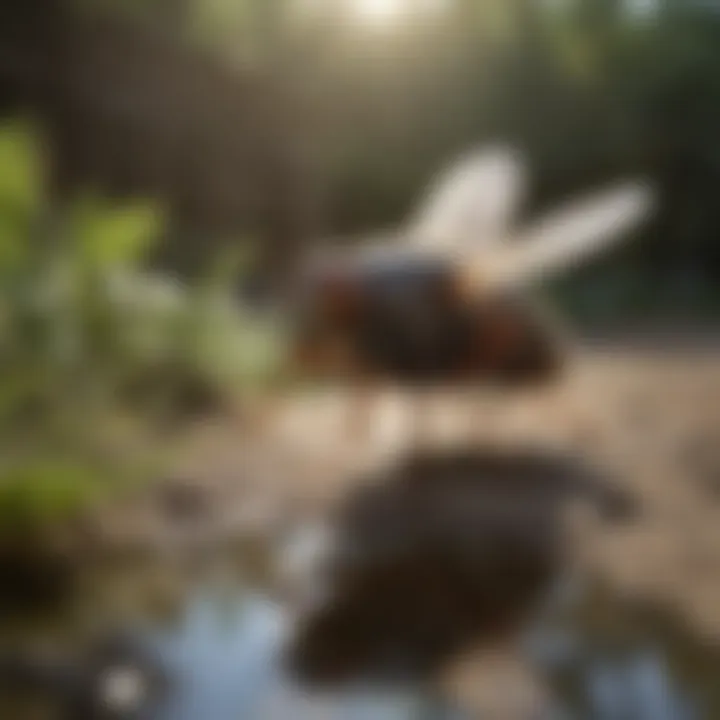
Conditions Favoring Swarming
Several key conditions encourage flies to swarm outdoors. Understanding these elements can help in preventing infestations before they occur.
Temperature and humidity
Temperature and humidity play a significant role in fly behavior. Flies prefer warm, humid environments which boost their reproductive rates. High temperatures and moisture create perfect conditions for both breeding and survival. Homeowners should monitor outdoor conditions and consider adjustments where possible, such as reducing standing water, to influence fly populations.
Availability of food sources
The presence of food sources is another crucial factor that attract flies. Open garbage bins, compost heaps, and any food waste can become hotspots for fly activity. Flies are particularly drawn to sugary or decaying food. Thus, ensuring that food sources are properly managed is vital for preventing an increase in their numbers.
Breeding sites
Breeding sites provide flies the perfect conditions to multiply. Areas with animal waste, stagnant water, and decaying matter serve as ideal breeding grounds. Recognizing these factors and minimizing them can substantially disrupt fly population growth. Disposing of waste properly and ensuring that gardens remain clean can limit breeding opportunities.
Identifying Common Outdoor Flies
Understanding the types of flies present in outdoor spaces is crucial for effectively managing their populations. Identifying common outdoor flies allows homeowners and housewives to tailor their control strategies more efficiently. Each fly species has unique habits, habitats, and attraction points. By knowing these details, one can make informed decisions on prevention and management practices.
House Flies
House flies, known scientifically as Musca domestica, are among the most familiar household pests. They are typically gray with four dark stripes on their thorax. These flies thrive in human environments where food waste is present. Their attraction to decaying organic material makes them common near garbage bins and compost areas.
The house fly’s life cycle is rapid; females can lay hundreds of eggs in their short lifetime. This trait contributes to their swift population growth in optimal conditions. Control measures include maintaining cleanliness in outdoor areas, covering food, and using traps or insecticides. By regularly disposing of waste and cleaning surfaces, homeowners can significantly reduce the likelihood of house flies congregating.
Fruit Flies
Fruit flies, particularly Drosophila melanogaster, are small and typically brownish-yellow with red eyes. They are most noticeable during warmer months, often hovering around ripe fruits and vegetables. Their presence signifies ripe or overripe produce, which can attract substantial swarms in a short time.
Dealing with fruit flies involves vigilance when it comes to food storage. Store fruits in sealed containers and dispose of any overripe items promptly. Cleaning up any spills or residual juice can help eliminate breeding sites. Options for control range from simple traps made with vinegar to commercial traps widely available in stores.
Flesh Flies
Flesh flies belong to the family Sarcophagidae and can be identified by their gray coloration, distinctive checkerboard pattern on the abdomen, and size, which is larger compared to house flies. They are often found near decaying animal matter or open wounds on animals. This makes them both a nuisance and a potential risk for health hazards.
Strategy for managing flesh flies involves minimizing their potential breeding sites. Removing carrion or decaying organic materials, especially during warmer months, is essential. Covering trash and ensuring animal waste is dealt with promptly are also effective measures.
In summary, identifying these common outdoor flies provides homeowners with critical insight into their behavior, habitats, and effective management strategies.
"Understanding the specific characteristics of each fly species can lead to more successful mitigation efforts."
By being proactive and implementing targeted measures, one can achieve a more pleasant outdoor environment free from the disturbances caused by these pests.
Assessing Attractants for Flies
Assessing attractants for flies is a crucial step in managing swarming issues outdoors. Understanding what draws flies to an area can help in implementing strategies to reduce their population. Flies are primarily driven by the search for food and breeding sites. Therefore, identifying and eliminating these attractants directly influences the effectiveness of pest control measures.
Food Sources
Flies are opportunistic scavengers, and their attraction to food sources is a significant factor in their presence outdoors. Common sources include open garbage bins, decaying organic matter, and unharvested fruits.
Open garbage bins
Open garbage bins are especially influential in attracting flies. Their key characteristic is the accessibility of decomposing food items. This makes them a primary target for swarming flies. The unique feature of open garbage bins is that they often offer a varied diet for flies, including leftover food, organic waste, and other debris. However, the main disadvantage is that they can quickly become breeding grounds for flies if not managed properly. Therefore, ensuring these bins are closed or properly maintained helps in reducing fly populations.
Decaying organic matter
Decaying organic matter, such as fallen leaves or fruit, serves as a magnet for various fly species. The decomposition process releases strong odors that attract flies and encourage their reproduction. The key characteristic of this matter is its abundance in gardens and landscapes, making it a prevalent issue. The advantage of recognizing this attractant is that it highlights the need for regular cleanup in outdoor areas. On the downside, neglecting this aspect can lead to a significant fly problem, as flies can breed in these environments and quickly multiply.
Unharvested fruits
Unharvested fruits are another attractant that can lead to swarming flies. The sweetness and scent of overripe or fallen fruits are highly appealing to them. This characteristic makes this attractant a common issue during gardening seasons. Their unique feature is that they provide both food and a place for flies to lay eggs. It is beneficial to regularly harvest ripe fruits and dispose of any spoiled ones. However, if not managed, this can easily become a source of problems, drawing fly populations near your outdoor spaces.
Breeding Sites
Beyond food sources, flies also need suitable breeding sites to establish their populations. Common breeding sites include standing water, compost piles, and animal waste.
Standing water
Standing water is a prime breeding site for flies. Stagnant water bodies create an ideal environment for flies to lay eggs. The key characteristic of standing water is that it promotes the growth of organic materials, which provide nourishment for larvae. Notably, such sites are often overlooked in pest control discussions. The clear advantage of identifying standing water early is the ability to eliminate potential breeding grounds. However, disregarding this factor can lead to rapid increases in fly populations.
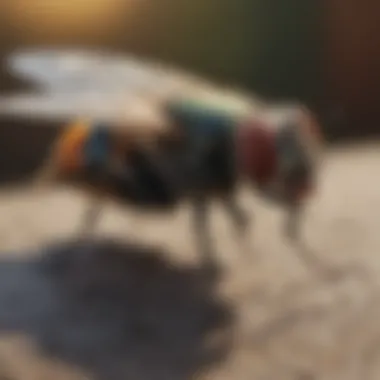
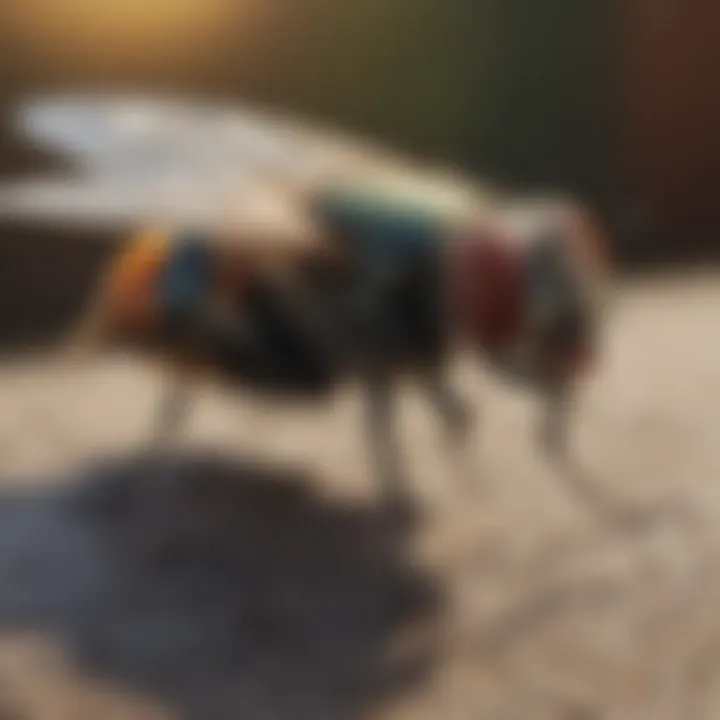
Compost piles
Compost piles can act as breeding grounds due to the heat produced during decomposition. This type of organic matter can attract flies seeking both food and shelter. The essential characteristic of compost piles is their rich nutrient content, which appeals to flies. By managing compost piles effectively, one can limit fly populations as they thrive in environments rich in waste. But if not turned or aerated regularly, piles can lead to significant fly issues over time.
Animal waste
Animal waste presents another key breeding site for flies. Its strong odor is a clear attractant, typically marking it as a fly's favorite breeding ground. This waste consists of nutrient-rich material that supports fly larvae. The primary benefit of acknowledging animal waste is that it prompts timely cleanups to discourage fly populations from flourishing. However, neglecting this can lead to overwhelming swarms, making it imperative to manage animal waste effectively in outdoor environments.
Recognizing and eliminating specific attractants is vital to effectively manage swarming flies outdoors.
Preventive Measures Against Swarming Flies
Preventive measures against swarming flies are crucial for maintaining a comfortable and healthy outdoor environment. Implementing such measures can significantly reduce the presence of flies, thus improving the quality of outdoor experiences. It is more efficient and practical to prevent infestations rather than dealing with them once they have occurred. The focus in this section is on specific actions that can be undertaken to deter flies from swarming, including sanitation practices and environmental modifications.
Sanitation Practices
Regular garbage disposal
Regular garbage disposal is an essential component of sanitation practice that plays a vital role in managing flies. Flies are attracted to waste materials, and poorly managed garbage can create a breeding ground for them. The key characteristic of regular garbage disposal is its simplicity; it involves routinely collecting and discarding waste to minimize fly attraction. This practice is highly beneficial because it helps to eliminate potential food sources and nesting sites for flies. One unique feature of this method is that it requires minimal investment but results in substantial benefits. However, neglecting this area could lead to an increase in fly populations that can become overwhelming over time.
Cleaning outdoor areas
Cleaning outdoor areas regularly contributes greatly to reducing fly swarming. This aspect includes removing debris, spills, and leftover food that can attract flies. The key characteristic of cleaning outdoor areas is consistency; it requires a routine approach to be effective. This practice is beneficial because it creates an uninviting environment for flies. A unique feature of this method is its ability to improve the overall aesthetic of outdoor spaces while keeping pests at bay. However, if not maintained, even a small accumulation of organic matter can attract flies, underscoring the need for diligent upkeep.
Proper food storage
Proper food storage is a preventive practice that significantly impacts fly management. Keeping food sealed and stored appropriately reduces the likelihood of attracting flies. The key characteristic of proper food storage is its preventive nature; it addresses the issue before it becomes a problem. This practice is beneficial because it not only keeps flies away but also helps in maintaining food safety and hygiene. The unique feature of this method is that it applies to various scenarios, from picnics to backyard barbecues. The main disadvantage is that it requires effort and discipline to ensure food is consistently stored correctly after use.
Environmental Modifications
Removing stagnant water
Removing stagnant water is a necessary environmental modification to prevent fly infestations. Flies breed in standing water, making this aspect crucial for controlling their population. Its key characteristic is the direct impact it has on reducing breeding sites. This practice is beneficial because it addresses a root cause of the problem. A unique feature of removing stagnant water is its broad applicability, as it can include anything from birdbaths to clogged gutters. However, ignoring this task can lead to a resurgence of flies in a short period.
Managing compost effectively
Managing compost effectively is important for ensuring it does not become a fly attractant. This aspect involves maintaining a balance of materials and aerating the compost pile. The key characteristic of effective compost management is creating conditions that discourage fly oviposition while promoting organic breakdown. This practice is beneficial as it allows for responsible waste management by converting organic matter into useful fertilizer. A unique advantage of this method is that it can attract beneficial insects while repelling pests when done correctly. However, improper management can lead to odors and attract flies, highlighting the need for knowledge in composting practices.
Reducing clutter
Reducing clutter in outdoor areas is another effective measure against fly infestations. Clutter can provide hiding spots and breeding areas for flies. The key characteristic of this practice is simplicity; it often consists of straightforward organizing and cleaning tasks. Reducing clutter is beneficial as it not only minimizes potential habitats for flies but also contributes to a more pleasing outdoor environment. A unique feature of this method is its dual advantage: improved hygiene along with enhanced aesthetics. However, some people may find it challenging to part with items or may underestimate the impact of clutter on pest control.
“Preventive measures are always more effective than reactive ones.”
By implementing these sanitation practices and environmental modifications, individuals can significantly reduce the risk of swarming flies and create a much more enjoyable outdoor living space.
Natural Control Methods
Natural control methods are pivotal in managing swarming flies effectively. These methods not only minimize the use of harmful chemicals but also provide a sustainable approach to pest control. By employing natural control strategies, individuals can address the underlying causes of fly infestations while promoting a healthier outdoor environment.
Essential Oils
Peppermint oil
Peppermint oil stands out for its strong scent, which is a well-known deterrent for various insects, including flies. Its high menthol content acts as a natural insect repellent. The freshness of peppermint oil not only helps in reducing fly numbers but also leaves a pleasant aroma in outdoor spaces. One unique feature of peppermint oil is its ability to mask the scents that attract flies, such as food waste. However, its effectiveness can diminish over time, necessitating regular application to maintain its repellent properties.
Lavender oil
Lavender oil is often celebrated for its calming fragrance, but it also serves as a potent fly repellent. The unique characteristic of lavender oil is its dual action; it not only repels flies but also attracts beneficial pollinators. This makes it a popular choice for gardeners wanting to manage pests while maintaining biodiversity. While it is generally safe to use, some individuals may find its scent overpowering or may have allergies to it, which should be taken into consideration.
Eucalyptus oil
Eucalyptus oil is another effective option for controlling flies outdoors. Its strong aromatic properties are known to repel not just flies, but also mosquitoes and other pests. Eucalyptus oil contains compounds that are effective at disrupting the sensory receptors of flies, making them less likely to approach treated areas. A significant advantage of eucalyptus oil is its long-lasting nature, but users must be cautious as it can be toxic to pets if ingested in large quantities.
Biological Control Agents
Biological control agents present an ecological approach to managing fly populations. Instead of relying on synthetic chemicals, these agents utilize natural predators or parasites to keep flies in check. This form of pest control aligns with sustainable gardening practices, promoting a healthier ecosystem.
Predatory insects
Predatory insects, such as certain species of wasps and beetles, are valuable allies in the fight against flies. They naturally prey on fly larvae and adults, reducing their numbers significantly. The key characteristic of these insects is their role as natural biocontrol agents. Utilizing predatory insects can lead to a balanced ecosystem, where pest populations are maintained at manageable levels. However, introducing them requires careful planning, as they must be compatible with existing species in the garden to avoid unintended consequences.
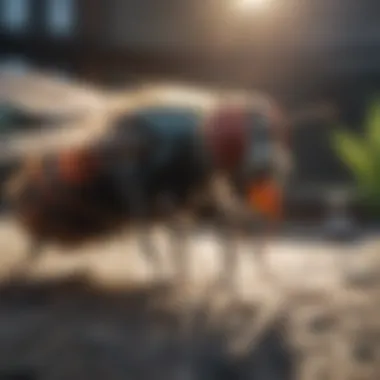
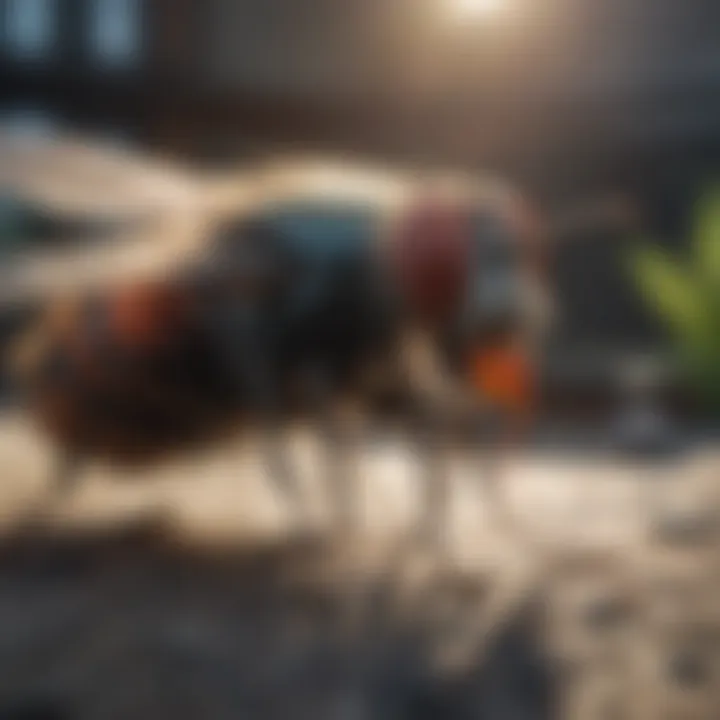
Nematodes
Nematodes are microscopic worms that serve as effective biological control agents against fly larvae. These natural parasites invade fly pupae, leading to their demise. One of the key benefits of using nematodes is their specificity; they target only certain pests without harming other beneficial insects. This makes them a reliable choice for those looking to control fly populations discreetly. However, specific conditions are necessary for their success, including soil moisture and temperature, meaning they must be used with some consideration.
Chemical Control Options
Chemical control measures play a vital role in mitigating the issue of swarming flies in outdoor spaces. These options provide a direct and often immediate response to fly infestations, which can be beneficial in densely populated areas or during peak seasons of fly activity. The effectiveness and quick action of chemical solutions make them a popular choice for homeowners seeking to reclaim their outdoor environments from pest disturbances.
Insecticides
Residual insecticides
Residual insecticides are an important tool in managing fly populations. They work by leaving a chemical film on surfaces, where flies are likely to land. One of the key characteristics of residual insecticides is their long-lasting effect, which can continue to kill flies over several days or even weeks after application. This property makes them immensely beneficial for controlling established fly populations.
However, one unique feature of residual insecticides is their requirement for careful application. Misapplication can lead to unwanted pesticide exposure to non-target species or the environment. Therefore, understanding the proper usage before application is vital. Prospective users of residual insecticides must weigh their efficiency against potential risks.
Fogging agents
Fogging agents offer another efficient chemical control choice for swarming flies. These are typically used for large outdoor areas and have the unique ability to disperse active ingredients in a fine mist, allowing for widespread coverage. This characteristic makes fogging agents effective in quickly reducing fly numbers in large settings, such as gardens or parks.
The advantage of fogging agents is the rapid knockdown effect they provide; flies are often killed within minutes of exposure. However, a major consideration is the precision of application. Fogging must be done at appropriate times, often early in the morning or late in the evening, to maximize effectiveness while minimizing the impact on beneficial insects and wildlife.
Traps and Baits
Traps and baits are alternative options that complement the use of insecticides. These methods provide a less invasive control option, targeting flies specifically with attractants.
Sticky traps
Sticky traps are a straightforward yet effective method for capturing flies. These traps are coated with an adhesive substance, which flies stick to upon landing. One of the key benefits of sticky traps is that they do not require the use of harmful chemicals. They can be placed in strategic locations, such as near breeding sites, to capture adult flies.
The advantage of using sticky traps is their ease of use and low environmental impact. However, these traps can be less effective in areas with heavy fly populations and may require regular checking and replacement to maintain their efficiency.
Liquid baits
Liquid baits are another effective control method for swarming flies. These consist of a liquid attractant mixed with a toxic agent that is appealing to flies. The primary characteristic of liquid baits is their ability to lure flies into consuming the poisonous liquid, leading to a reduction in fly numbers. This method can be particularly effective at baiting flies in areas where they are commonly seen, such as near food sources.
The significant benefit of liquid baits is their potent attraction, which can draw in flies that are otherwise difficult to capture. However, care must be taken to ensure that pets or other wildlife do not have access to these bait stations, as safety is a major consideration in their use.
Long-term Management Strategies
Managing flies in outdoor areas requires a strategic approach. Implementing long-term management strategies is crucial for preventing swarming flies, as it focuses on sustainable practices that minimize the constant need for reactive measures. This proactive mindset not only enhances the effectiveness of fly control but also promotes a healthier environment.
Focusing on methods like Integrated Pest Management (IPM) offers benefits that extend beyond immediate fly reduction. Practicing IPM means incorporating various techniques, such as sanitation, cultural practices, and biological controls. This holistic approach considers the entire ecosystem. It recognizes that while flies can be a nuisance, they're also part of the natural world. Balancing these elements ensures fewer disruptions in the environment.
Moreover, monitoring fly populations is significant for effective long-term management. By understanding the patterns and behaviors of flies in your area, homeowners can adjust their strategies accordingly. This can lead to more informed choices regarding when and how to implement control measures.
In summary, long-term management strategies emphasize the importance of planning, observation, and ecological balance. Being proactive is essential in eliminating swarming flies effectively.
Integrated Pest Management (IPM)
Integrated Pest Management (IPM) combines multiple strategies to control pest populations effectively. This method allows for a more sustainable approach to eliminate flies. Some key aspects of IPM include:
- Monitoring: Regular assessments of fly populations help identify problem areas.
- Sanitation: Keeping outdoor spaces clean reduces attractants for flies. This means regular disposal of garbage and cleaning spills promptly.
- Habitat Modification: Altering environments, such as removing breeding sites, is vital. Eliminating standing water and decaying matter can significantly decrease fly numbers.
- Natural Predators: Encouraging predators, like certain insects, can help control fly populations naturally.
Implementing IPM requires some initial effort, but the long-term benefits far outweigh the challenges. It decreases reliance on chemical methods while providing a comprehensive approach to managing flies.
Monitoring Fly Populations
Monitoring fly populations is essential for maintaining control and effectiveness of management strategies. Regular inspections provide valuable insights into the status of fly activity. This process involves:
- Identifying Species: Understanding which types of flies are prevalent can help tailor control efforts more precisely.
- Setting Traps: Using traps for monitoring allows for practical and visual assessment of fly numbers.
- Assessing Conditions: Evaluating climate and habitat changes can indicate potential infestations before they escalate.
- Data Recording: Keeping a log of observations over time helps in recognizing trends and determining the most effective interventions.
Regular monitoring is vital for long-term success. Without it, management strategies may become ineffective or misaligned with actual conditions.
Culmination
The conclusion section of this article is crucial as it encapsulates the essence of the strategies discussed for managing swarming flies in outdoor environments. It provides a comprehensive overview, reinforcing the importance of both effective techniques and preventive measures. Furthermore, it synthesizes the various ideas proposed throughout the article, facilitating a clearer understanding of the overall subject matter.
Summary of Effective Techniques
In summary, several effective techniques have been highlighted for eliminating swarming flies outdoors. These include adopting strict sanitation practices, such as regular garbage disposal and thorough cleaning of outdoor spaces. Additionally, environmental modifications play a significant role; actions like removing stagnant water and managing compost can deter flies significantly.
Natural control methods, such as using essential oils like peppermint or lavender, have also shown promise in repelling flies without harming other beneficial insects. For immediate fly control, chemical options, including residual insecticides and traps, can be employed strategically. The variety of options available allows homeowners to choose methods that best suit their specific outdoor environments.
Encouraging a Pest-Free Environment
Encouraging a pest-free environment necessitates ongoing vigilance and commitment from homeowners. Simple steps can lead to significant improvements in controlling fly populations. This involves not only implementing the proactive measures outlined previously but also fostering a culture of cleanliness and awareness within the household. Regular maintenance of the yard, including prompt disposal of food scraps and proper storage of materials that attract flies, can significantly reduce the likelihood of infestations.
Moreover, educating family members about the importance of these practices will create a shared responsibility, reinforcing the efforts made. Utilizing community resources, such as local environmental agencies or neighborhood clean-up events, can also bolster efforts to create a sustainable solution against swarming flies. Homeowners are encouraged to take initiative, turning their outdoor spaces into areas that are less inviting to pests, thereby promoting a more enjoyable living environment.







